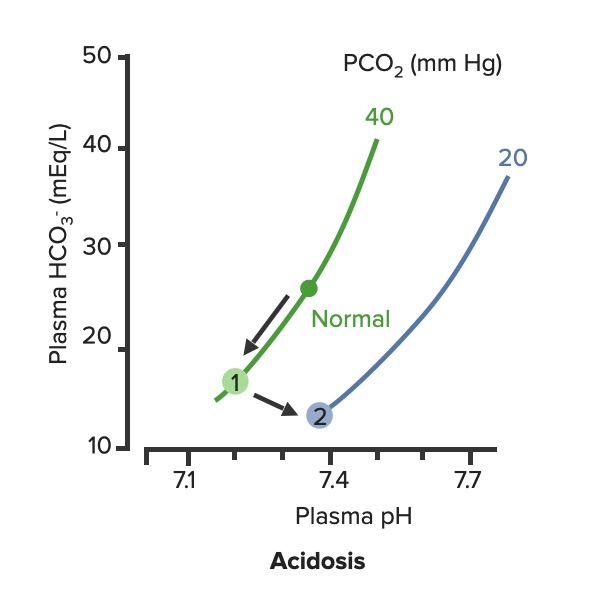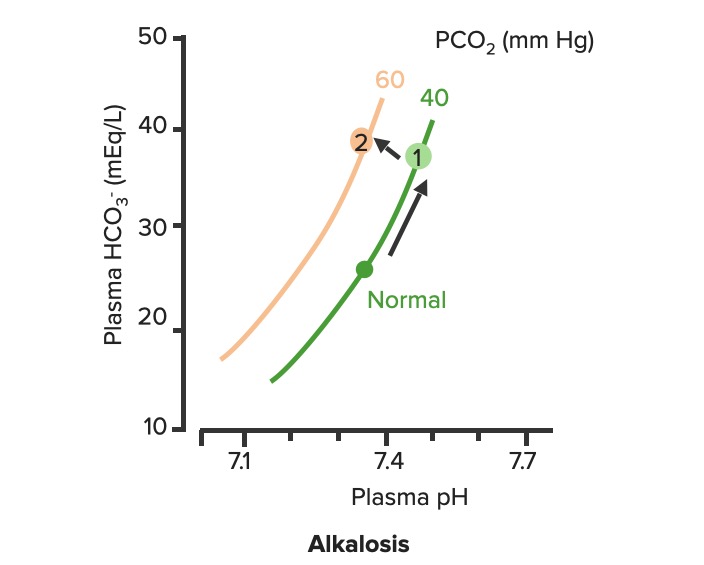Playlist
Show Playlist
Hide Playlist
Approach to Acid Base Status: Step 5 – Laboratory Diagnostics
-
Slides DiagnosticsAcidosisAlkidosisStep3-5 RespiratoryPathology.pdf
-
Reference List Pathology.pdf
-
Download Lecture Overview
00:01 Speaking of which, for an anion gap metabolic acidosis, one more time, here's a mnemonic. 00:10 A lot of these were already talked about. 00:13 Our focus earlier was on DKA and it was on ethylene glycol but you have MUDPILES here. 00:19 On the other side for metabolic acidosis, non-anion gap. 00:24 And these we've talked about especially the RTA, renal tubular acidosis. 00:31 The aldosterone dysfunction there, either Addison or RTA-Type IV or Spironolactone. Please put those together. 00:39 One again, a big point here, under non-anion gap metabolic acidosis. 00:45 What is your anion gap and non-anion gap? And I would be careful. 00:49 Clinically, that's a silly name but that's within a normal limit. 00:53 Okay. So, it will be between your 10 and 14 and such, about approximately 10. 00:58 Anion gap metabolic acidosis, all of those will be above 10, most likely in the 20s. 01:04 Now, differentials. If a patient has respiratory acidosis, what if the respiratory center has been knocked out? Hypoventilation from holding on to carbon dioxide. 01:20 Maybe your patient's suffering from amyotrophic lateral sclerosis, in other words, Lou Gehrig. 01:27 What happens? You're gonna have your sensory intact but your motor is dysfunctional, isn't it? Or there is something on Guillain-Barre and Guillain-Barre, maybe your patient is suffering from influenza virus or maybe even a varicella or shingles. 01:44 If that's the case, then soon thereafter, they must've had an ascending type of paralysis up their body. 01:49 Oh, no. It's gonna hit my diaphragm. Oh, boy. 01:53 If your diaphragm isn't working anymore, then what's your breathing pattern? Decreased. Welcome to respiratory acidosis. 02:00 Upper airway abnormalities. We'll talk about these. 02:03 It's obstruction, laryngospasms or obstructive sleep apnea, OSA is a huge topic, isn't it? Obesity is an epidemic. 02:13 So, therefore, look for obstructive. 02:15 It's a big deal cuz it could actually result in sudden, sudden death. Be careful. 02:21 Lower airway abnormalities: COPDs. 02:24 Thoracic cage abnormalities. I told you about kyphoscoliosis. 02:28 That's when the thoracic cage literally becomes too small where the lungs cannot expand. 02:33 Welcome to respiratory acidosis. 02:34 Lung parenchymal diseases or literally respiratory muscles are going to fatigue. 02:39 Respiratory alkalosis. 02:43 Here we have the following differentials. 02:45 A lot of this is going to be associated with hyperventilation, hyperventilation, hyperventilation. 02:51 Be careful with cirrhosis. 02:53 Oftentimes with cirrhosis you will have what's known as hepato-pulmonary disease. 02:57 Increased, increase respiration, you're blowing off your carbon dioxide. 03:01 Tell me about your compensation. 03:03 Your compensation is going to be kidney, acute and then chronic. 03:08 Now, hypoxia, whatever the cause, oftentimes, hyperventilation, then followed by hypoxia. 03:15 Keep that in mind please, especially when you deal with COPDs. 03:18 Metabolic alkalosis. Let me show you the following. 03:21 First down, they were really seeing metabolic alkalosis and we have spent a heck of a lot of time on metabolic acidosis for obvious reasons. 03:30 All those differentials, anion gap, MUDPILES, non-anion gap, well, you know that mnemonic. 03:39 Give yourself an example such as aldosterone deficiency. 03:42 Now, what's interesting about metabolic alkalosis is, well, is your patient sensitive to saline or not? If your patient with metabolic alkalosis is saline responsive, generally, urine chloride is low and GI loss, diuretics, and post-hypercapnia. 04:05 You'll notice, GI loss, emesis, nasogastric tube, villous adenoma. 04:10 Those are ones in which your patient, if they're suffering from metabolic acidosis, when you give them saline, they are going to be responsive. 04:19 So, what's your PH here? Increased. 04:21 What's your bicarb here? Increased. 04:23 What's your carbon dioxide here? Increased with compensation. 04:27 Now, take a look at these. These are saline resistant. 04:31 What I wish to bring to your attention is the following. 04:34 A lot of information here, things could get confusing but keep them straight. 04:38 Luckily, you're at home and you can go through this in digestible parts. 04:44 Saline resistant, this is mineralocorticoid excess diseases. 04:48 Whereas if we talked about while you're non-anion gap metabolic acidosis, that was what? Aldosterone dysfunction. 04:57 For example, Addison's and company or RTA-Type IV. 05:00 So, mineralocorticoid excess gives you the following. 05:03 We have hyperaldosteronism, Cushing, exogenous administration. 05:08 The other big one here would be something like licorice, Bartter, and Gitelman. 05:13 The reason why licorice is here, especially black licorice is it has mineralocorticoid activity. 05:19 So, therefore, the patient how is suffering from metabolic alkalosis. 05:22 Think about too much aldosterone. What is it doing? Whoop, whoop, whoop, whoop, what is this, the noise that I'm making? I am sending out hydrogen into the urine. 05:29 So, therefore result in metabolic alkalosis. 05:33 In mineralocorticoid excess, it doesn't matter if you give them saline. 05:36 They're not going to respond. It doesn't make any sense. 05:39 There's no volume depletion per se. 05:41 Metabolic alkalosis divide into saline responsive and resistant clinically.
About the Lecture
The lecture Approach to Acid Base Status: Step 5 – Laboratory Diagnostics by Carlo Raj, MD is from the course Pulmonary Diagnostics.
Included Quiz Questions
Which of the following conditions leads to a saline responsive type of metabolic alkalosis?
- GI loss
- Gitelman's syndrome
- Hyperaldosteronism
- Cushing's syndrome
- Mineralocorticoid excess
Guillain-Barre syndrome can cause which of the following conditions?
- Respiratory acidosis
- Respiratory alkalosis
- Metabolic alkalosis
- Anion gap metabolic acidosis
- Non-anion gap metabolic acidosis
Which of the following does not cause a saline resistant type of metabolic alkalosis?
- Furosemide
- Cushing's syndrome
- Hyperaldosteronism
- Gitelman's syndrome
- Licorice
Customer reviews
5,0 of 5 stars
| 5 Stars |
|
5 |
| 4 Stars |
|
0 |
| 3 Stars |
|
0 |
| 2 Stars |
|
0 |
| 1 Star |
|
0 |








